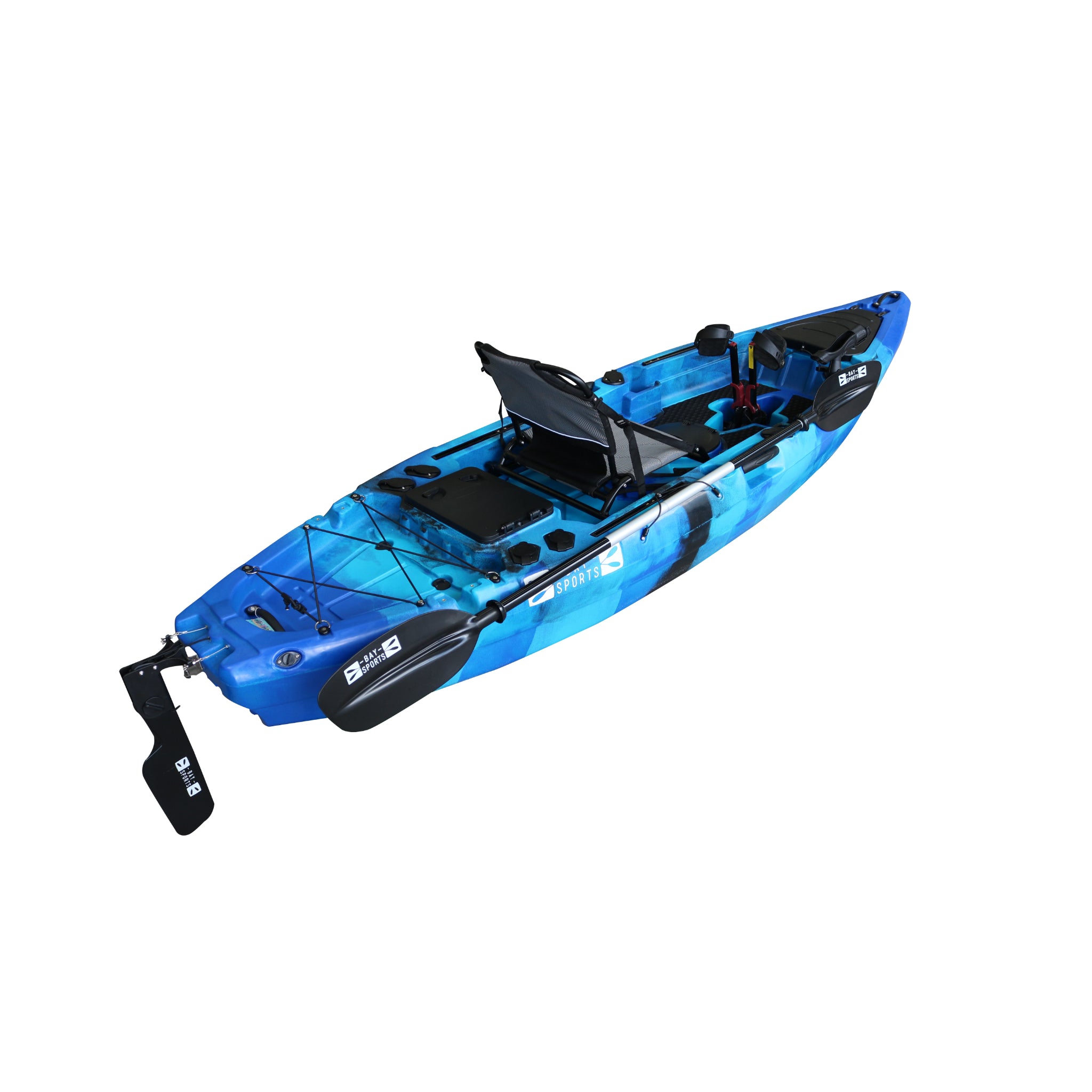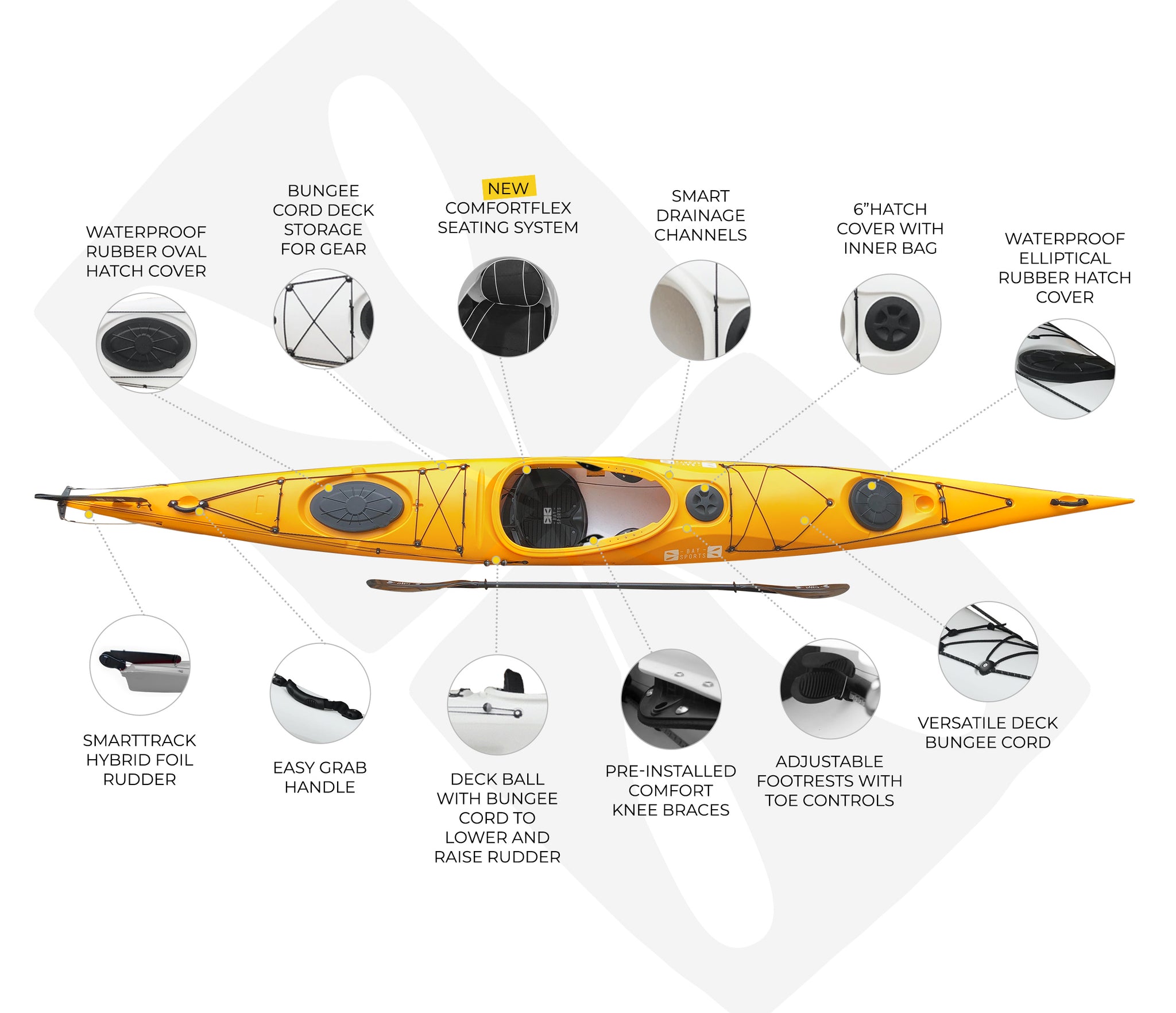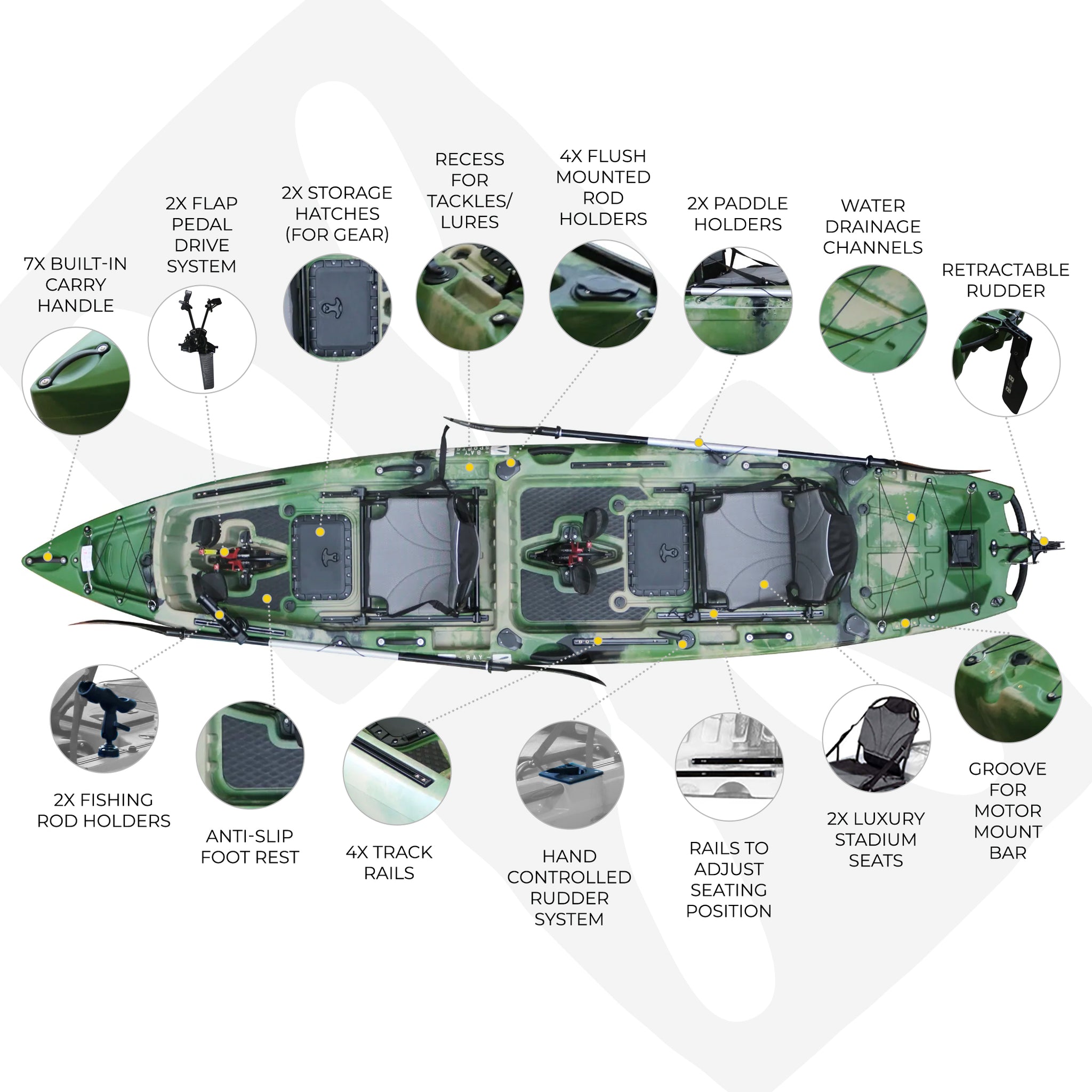Choosing the Perfect Fishing Kayak
Mar 20, 2024
Dipping a paddle into serene waters or navigating Australia's rugged coastlines, kayak fishing offers an immersive experience unlike any other. Yet, the key to truly unlocking this adventure lies in selecting the right vessel. In the vast world of kayaking, each boat is crafted with unique purposes in mind. We will guide you through the considerations and nuances, ensuring your next trip is paired with a kayak tailored to your angling ambitions.
Understand Your Fishing Needs
Types of Water
Understanding the kind of water you'll be predominantly fishing in is crucial as it directly influences the kind of kayak that's best suited for you.
Freshwater
Lakes and Dams:
- Features: Generally calm with still waters, larger open spaces.
- Best Kayak Features: Stability for casting, storage for long days or camping trips, and a comfortable seat.
Rivers and Streams:
- Features: Moving water, potentially with rapids or tight turns.
- Best Kayak Features: Good manoeuvrability, shorter length for navigating around obstacles and shallower draft for shallow areas.
Saltwater
Estuaries and Bays:
- Features: Mix of calm and moving waters, potential for larger fish species.
- Best Kayak Features: Stability, more substantial storage for catch, rod holders, and anchor systems.
Open Ocean:
- Features: Exposed conditions, larger swells, wind, and potential for big game fish.
- Best Kayak Features: Longer design for speed, V-shaped hull for cutting through waves, rudder system for steering, and extra safety features.
Target Fish Species
Knowing what you're fishing for not only dictates the gear you'll need but also the design of the kayak.
Small to Medium Freshwater Species (e.g., bass, trout):
- Best Kayak Features: Moderate stability, easy manoeuvrability, smaller storage compartments for tackle and catch.
Large Freshwater Species (e.g., Murray cod, catfish):
- Best Kayak Features: High stability, robust rod holders, more considerable storage or live wells.
Inshore Saltwater Species (e.g., bream, flathead):
- Best Kayak Features: Good manoeuvrability for navigating around structures, adequate storage for larger tackle boxes.
Offshore Saltwater Species (e.g., tuna, marlin):
- Best Kayak Features: Exceptional stability for fighting big game fish, reinforced rod holders, storage for bigger catch, safety features like paddle leashes and visibility flags.
Frequency of Use
How often you plan to be on the water plays a significant role in determining the type of investment you should make in a kayak.
Occasional Use:
- Perhaps you'll fish only a few times a year.
- Best Kayak Features: Cost-effective, basic features, easy to store.
Regular Weekends:
- Hitting the waters almost every weekend?
- Best Kayak Features: Durable materials, enhanced comfort for longer hours on water, extra storage compartments for varied fishing needs.
Frequent or Professional Use:
- If fishing is more of a passion or profession.
- Best Kayak Features: Top-of-the-line materials, adjustable and ergonomic seating, customisation options for gear, advanced safety features, and warranty considerations.
Understanding the specifics of where you'll fish, what you're targeting, and how often you'll be on the water, can drastically refine your search for the perfect fishing kayak. It's about tailoring your kayak to your unique requirements, ensuring every trip is as fruitful and enjoyable as possible.

Paddle vs. Pedal Kayaks
When it comes to propelling your fishing kayak, the classic method involves a paddle. However, with innovation in the kayaking world, pedal-driven systems have also become increasingly popular. Both methods come with their pros and cons, and understanding these can help tailor your choice based on your personal preference and fishing environment.
Paddle Kayaks
Traditional and Time-tested
Paddle kayaks have been around for centuries, and their design has been refined over time to enhance the fishing experience.
Advantages of Paddle Kayaks
- Cost: Paddle kayaks tend to be more affordable as they come without the complex pedal mechanism. For someone on a budget or just starting out, this might be a more feasible option.
- Simplicity: The fewer components a kayak has, the fewer things can go wrong. Paddle kayaks are straightforward and often require less maintenance.
- Versatility: Paddle kayaks can be easily manoeuvred in both freshwater and saltwater environments, allowing you to access tight spots with ease.
- Lighter Weight: Without the added weight of a pedal system, paddle kayaks are generally lighter and easier to transport.
Drawbacks
- Physical Strain: Paddling can be tiring, especially on longer journeys. It requires good upper body strength and technique to paddle efficiently.
- Hands Not Free: One major drawback for anglers is that you can't paddle and fish simultaneously, which means stopping each time you cast or reel in.

Pedal Kayaks
Modern Innovation for Hands-free Fishing
Pedal kayaks have emerged as a favourite for many anglers, offering a unique way to traverse waters.
Benefits of Pedal Kayaks
- Hands-Free Fishing: The most significant advantage is the ability to pedal with your legs and have both hands free for fishing. This means you can manoeuvre while casting, trolling, or reeling in a catch.
- Speed: Legs are generally stronger than arms. Pedalling can help achieve greater speeds and cover larger distances with less fatigue.
- Endurance: Using your legs can be less tiring over extended periods, allowing you to stay out on the water longer.
- Stealth: Some anglers believe that the quiet pedal motion is less likely to scare fish compared to the splashing of paddles.
Drawbacks
- Cost: Pedal systems can significantly increase the kayak's price. They incorporate intricate mechanisms that also add to the kayak's weight.
- Maintenance: Moving parts in the pedal system can wear out or break and may require regular maintenance or replacements.
- Shallow Water Limitations: The pedal system can be a hindrance in very shallow waters or areas with a lot of underwater vegetation.
While both paddle and pedal kayaks have their unique benefits, the best choice often comes down to personal preference, budget, and the specific waters you'll be fishing in. Some anglers even own one of each, allowing them to choose based on their fishing plans for the day. Remember, the ultimate goal is to enhance your fishing experience, so choose the one that aligns best with your vision of a perfect day out on the water.
Inflatable Fishing Kayaks
In recent years, the allure of inflatable fishing kayaks has become hard to ignore. These portable marvels offer a fresh take on the traditional kayaking experience. However, like all products, they come with their distinct set of pros and cons.
Advantages of Inflatable Fishing Kayaks
- Portability: The primary draw of inflatable kayaks is their compactness when deflated. This portability is a boon for those without the luxury of a roof rack or large vehicle storage.
- Easy Storage: Their compact nature when deflated also means they don't demand extensive storage solutions like outdoor racks or a spacious garage. A closet or a small corner is often sufficient.
- Weight: Generally, inflatable kayaks are lighter than their hard-shell counterparts, which makes the journey from your vehicle to the waterside less strenuous.
- Stability: The buoyant characteristics of inflatable kayaks often lead to enhanced stability on the water, a feature especially cherished by anglers.
- Cost-Effectiveness: In many instances, inflatable kayaks can be a more wallet-friendly option compared to hard-shell models.
Potential Drawbacks
- Setup Time: The process of inflating can add to your preparation time, which might be a deterrent for some eager to hit the waters.
- Durability: Despite being crafted with robust materials, inflatable kayaks can still be susceptible to punctures, particularly when navigating waters with sharp obstacles.
- Performance Limitations: When discussing speed and tracking, hard-shell kayaks generally hold an edge over their inflatable peers.
- Maintenance Needs: Post-use care, particularly after saltwater exposure, is paramount. Ensuring the kayak is thoroughly rinsed and dried can significantly extend its lifespan.
Tips for Navigating with Inflatable Fishing Kayaks
- Routine Inspections: Before any excursion, it's prudent to check your kayak for signs of wear or possible leaks. Addressing minor issues onshore can prevent larger problems in the middle of your fishing session.
- Skeg Utilisation: Several inflatable kayaks offer a detachable skeg, aiding in better tracking, particularly during windy conditions.
- Always Be Prepared: Carrying a repair kit can be a trip-saver. Despite meticulous care, unexpected situations can arise, and a timely patch-up can keep the fun alive.
- Know Your Terrain: While inflatable kayaks boast versatility, they might not be ideal for extremely challenging waters or zones littered with sharp obstacles.
Inflatable fishing kayaks present a blend of convenience and functionality. For many, the benefits far outweigh the drawbacks. It's all about understanding your needs, the conditions you'll most often face, and making an informed choice. The end goal remains unchanged: a fulfilling and serene fishing experience.

Sea vs. Touring Kayaks
When it comes to longer paddling adventures, two types of kayaks often come to the forefront: sea kayaks and touring kayaks. Though they share certain similarities, the differences in design and purpose are evident upon closer inspection.
Sea Kayaks
Designed specifically for open water conditions like oceans and large bays, sea kayaks are built to handle the challenges posed by such environments.
Characteristics & Benefits of Sea Kayaks
- Length: Sea kayaks are typically longer, often exceeding 5 metres. This length helps in achieving better straight-line speed and improved tracking.
- Narrow Beam: They tend to be narrower, which also aids in speed and reduces the effect of crosswinds.
- Bow and Stern Design: The upturned bow and stern, known as rocker, improve manoeuvrability in waves.
- Storage: Equipped with watertight storage compartments for longer expeditions.
- Safety Features: Bulkheads and sealed compartments can trap air, aiding in buoyancy if the kayak is swamped.
Drawbacks
- Manoeuvrability in Tight Spaces: Their length can make them less agile in tight spaces like narrow riverways or small creeks.
- Weight: Due to their size and additional features, they can be heavier than other kayak types.
Touring Kayaks
Touring kayaks, often also referred to as recreational kayaks, are versatile vessels designed for a variety of conditions, from calm lakes to slow-moving rivers and coastal waters.
Characteristics & Benefits of Touring Kayaks
- Length: Typically shorter than sea kayaks, often ranging from 3.5 to 4.5 metres.
- Width: They have a wider beam, which provides increased stability, especially for beginners.
- Flat Bottom: Many touring kayaks have a flatter hull, offering more initial stability in calm conditions.
- Storage: They usually have ample storage, though not always as watertight as sea kayaks.
- Versatility: Suitable for a range of conditions, making them a popular choice for paddlers who want one kayak for various adventures.
Drawbacks
- Speed: Generally, touring kayaks are slower than sea kayaks due to their shorter length and wider beam.
- Handling in Rough Waters: They might not handle choppy conditions or large waves as adeptly as sea kayaks.
The choice between sea and touring kayaks boils down to intended use. For dedicated ocean adventures and long-distance expeditions, a sea kayak might be more apt. However, if you're after a versatile vessel for weekend trips across various water conditions, a touring kayak could be your best bet. Regardless of the choice, ensure that safety measures are always in place, and the kayak suits your skill level and comfort.
Best Kayak for Rivers and Lakes
Rivers
When it comes to rivers, especially those with rapid currents or obstructions, you'd want a kayak that offers nimbleness and a higher degree of control.
- Whitewater Rivers: For turbulent waters with rapids, a shorter, more robust kayak with a high rocker (the curve from bow to stern) is ideal. This design offers quick turns and can handle bumps and knocks against rocks.
- Slow-Moving Rivers: For gentler river flows, longer kayaks with good tracking capabilities are apt. They'll allow you to maintain a straight line and cover distances more efficiently.
Lakes
Lakes, particularly the large and expansive ones, can sometimes mimic the conditions of open seas, especially when it's windy.
- Large Lakes: You'd want a kayak with good tracking ability, ideally a touring or sea kayak. The added length aids in keeping a straight line across vast stretches.
- Smaller Lakes or Ponds: A shorter, wider kayak is suitable, offering stability and ease of manoeuvrability.
Sit-on-top vs. Sit-inside Kayaks
Sit-on-top Kayaks
These are more user-friendly, generally wider and offer greater stability.
- Pros: Easy to get on and off; self-draining through scupper holes; generally more stable due to a wider beam.
- Cons: You're more exposed to water, which can be a downside in colder climates.
Sit-inside Kayaks
These kayaks offer a cockpit where the paddler sits inside.
- Pros: Provides shelter from wind and water; offers a lower centre of gravity, enhancing secondary stability.
- Cons: Can fill with water if flipped, requiring a bilge pump or other means to empty; a bit more challenging for beginners to get in and out.
Length and Width Considerations
Length
- Shorter Kayaks (<3 metres): More agile, ideal for rivers with obstacles or tight turns.
- Longer Kayaks (>5 metres): Better for open water, as they track straighter and can achieve higher speeds.
Width (or Beam)
- Narrow (<60cm): Typically faster and more agile but can be less stable.
- Wide (>75cm): Offers greater stability, especially for beginners or those fishing.
Material and Durability
Kayaks can be made from various materials, each offering a unique blend of durability, weight, and cost.
- Polyethylene: Durable and affordable but heavier.
- ABS Plastic: Offers a balance between durability and weight; more UV resistant than polyethylene.
- Composite (like fibreglass or carbon fibre): Lightweight and fast but can be more expensive and less durable against impacts.
Portability and Transportation
Moving your kayak safely and efficiently is as important as the kayak's on-water performance. Here’s a succinct look into transportation aspects:
Hard-shell Kayaks
- Roof Racks: Secure and versatile; ideal for most vehicles. Kayak-specific mounts can offer extra stability.
- Trailers: Best for multiple or oversized kayaks. Ensure it's designed specifically for kayaks.
- Carry Handles & Carts: Useful for short treks from parking spots to the water.
Inflatable Kayaks
- Backpacks & Cases: Compact storage and transportation in the car boot or on your back.
- Pumps: While manual pumps work, electric ones make inflation swift.
Modular & Foldable Kayaks
- Modular Kayaks: Compact sections for easy assembly and transport.
- Foldable Kayaks: Combine portability with the rigidity of hard-shell kayaks.
Transportation Safety Tips
- Secure Firmly: Always double-check tie-downs.
- Flagging: Use safety flags for extended kayaks.
- Maintenance: Regularly inspect and maintain transportation equipment.
Your kayak's portability and transportation ease can greatly influence your overall experience, so choose methods fitting your lifestyle and routine.

Budget and Value
Every kayaker wants to ensure that they're getting the best value for their money. This doesn't necessarily mean choosing the cheapest option, but rather selecting a kayak that aligns with one's needs, preferences, and budget.
Understanding Price Points
- Entry-Level Kayaks (Budget Range): Often priced lower and are typically basic in design and features. They are excellent for beginners or occasional users but might lack some of the more advanced features or durability of higher-end models.
- Mid-Range Kayaks: These are a sweet spot for many. They often incorporate more advanced design elements, improved materials, and additional features without breaking the bank.
- Premium Kayaks: These are at the top-end of the market, catering to enthusiasts and professionals. They are crafted from high-quality materials, often lightweight, and come with various advanced features.
Assessing Value
- Material and Construction: The build quality directly influences durability. Look for kayaks made from UV-resistant and impact-resistant materials, ensuring longevity.
- Included Features: A higher price tag often brings additional features like adjustable footrests, better seating, storage solutions, and mount points for accessories.
- Brand Reputation: Established brands usually come with a guarantee of quality and often offer better after-sales services.
Hidden Costs
When calculating your budget, account for potential extras:
- Accessories: Paddles, life vests, fishing mounts, or storage solutions might come at an added cost.
- Maintenance: While kayaks generally require low maintenance, potential repairs or replacements can add to your expenses over time.
- Transportation: If your vehicle isn't already equipped, you might need roof racks or a kayak trailer.
Making an Informed Decision
- Research: Read reviews, join kayaking forums, or consult with local kayaking clubs to gather opinions.
- Try Before You Buy: Many dealers or clubs offer demo days. Testing a kayak ensures you're comfortable with your choice.
In essence, while it's tempting to make a decision based purely on cost, it's more important to find a kayak that offers true value for your individual needs. This might mean investing a bit more initially but saving on potential future costs.
Conclusion
Choosing the perfect fishing kayak is akin to selecting the right gear for any adventure. It's about ensuring you have the ideal equipment tailored to your needs, guaranteeing countless hours of enjoyment on the water. Just as Bay Sports offers a diverse range of top-notch fishing kayaks, the perfect choice ensures a seamless, enjoyable experience every time you venture out.
Before committing, remember to consider your individual needs, the environment you'll be fishing in, and the features that matter most to you. The Australian waters, whether freshwater or saltwater, offer a unique and rewarding experience. Having the right kayak not only ensures your safety but also elevates the pleasure of each adventure.
Lastly, when in doubt, reach out to fellow kayak enthusiasts or fishing experts. Australia is home to a vibrant community of anglers, many of whom would be delighted to share their insights. By doing your research, trialling various options, and investing in the perfect kayak from Bay Sports, you're gearing up for countless memorable journeys amidst the beauty of Australia's waters.
Happy paddling and tight lines! Remember, the joy of the journey often rivals the thrill of the destination.

